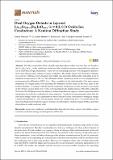Por favor, use este identificador para citar o enlazar a este item:
http://hdl.handle.net/10261/182967COMPARTIR / EXPORTAR:
 SHARE SHARE
 CORE
BASE CORE
BASE
|
|
| Visualizar otros formatos: MARC | Dublin Core | RDF | ORE | MODS | METS | DIDL | DATACITE | |

| Título: | Dual oxygen defects in layered La1.2Sr0.8−xBaxInO4+δ (x = 0.2, 0.3) oxide-ion conductors: a neutron diffraction study |
Autor: | Troncoso, Loreto; Mariño, Carlos; Arce, Mauricio D.; Alonso, J. A. CSIC ORCID | Palabras clave: | Oxygen-ion conductor Solid electrolyte Layered perovskite Oxygen interstitials Oxygen vacancies Activation energy Neutron powder diffraction |
Fecha de publicación: | 17-may-2019 | Editor: | Multidisciplinary Digital Publishing Institute | Citación: | Materials 12(10): 1624 (2019) | Resumen: | The title compounds exhibit a K2NiF4-type layered perovskite structure; they are based on the La1.2Sr0.8InO4+δ oxide, which was found to exhibit excellent features as fast oxide-ion conductor via an interstitial oxygen mechanism. These new Ba-containing materials were designed to present a more open framework to enhance oxygen conduction. The citrate-nitrate soft-chemistry technique was used to synthesize such structural perovskite-type materials, followed by annealing in air at moderate temperatures (1150 °C). The subtleties of their crystal structures were investigated from neutron powder diffraction (NPD) data. They crystallize in the orthorhombic Pbca space group. Interstitial O3 oxygen atoms were identified by difference Fourier maps in the NaCl layer of the K2NiF4 structure. At variance with the parent compound, conspicuous oxygen vacancies were found at the O2-type oxygen atoms for x = 0.2, corresponding to the axial positions of the InO6 octahedra. The short O2–O3 distances and the absence of steric impediments suggest a dual oxygen-interstitial mechanism for oxide-ion conduction in these materials. Conductivity measurements show that the activation energy values are comparable to those typical of ionic conductors working by simple vacancy mechanisms (~1 eV). The increment of the total conductivity for x = 0.2 can be due to the mixed mechanism driving both oxygen vacancies and interstitials, which is original for these potential electrolytes for solid-oxide fuel cells. | Descripción: | © The Author(s). | Versión del editor: | https://doi.org/10.3390/ma12101624 | URI: | http://hdl.handle.net/10261/182967 | DOI: | 10.3390/ma12101624 | ISSN: | 1996-1944 | E-ISSN: | 1996-1944 |
| Aparece en las colecciones: | (ICMM) Artículos |
Ficheros en este ítem:
| Fichero | Descripción | Tamaño | Formato | |
|---|---|---|---|---|
| Dual_Troncoso_Art2019.pdf | 1,88 MB | Adobe PDF |  Visualizar/Abrir |
CORE Recommender
PubMed Central
Citations
5
checked on 16-mar-2024
SCOPUSTM
Citations
28
checked on 16-abr-2024
WEB OF SCIENCETM
Citations
17
checked on 23-feb-2024
Page view(s)
181
checked on 19-abr-2024
Download(s)
233
checked on 19-abr-2024

